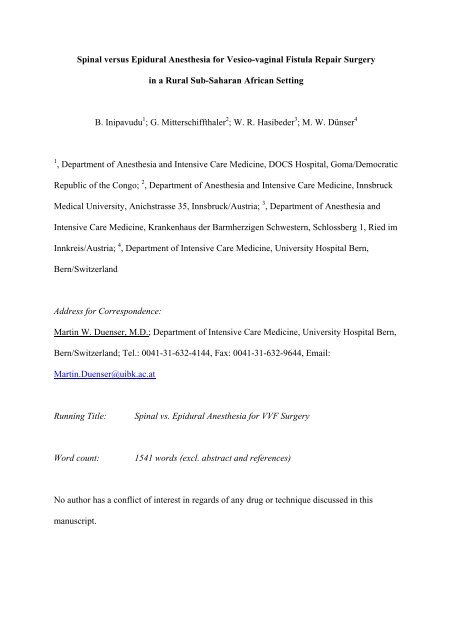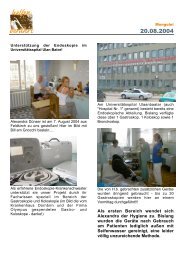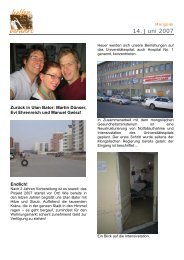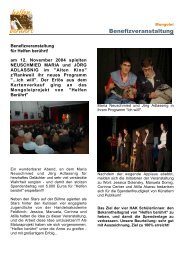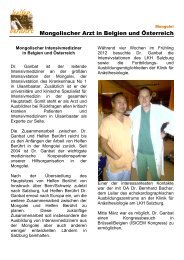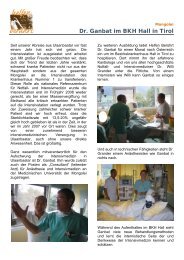Spinal versus Epidural Anesthesia for Vesico-vaginal Fistula Repair ...
Spinal versus Epidural Anesthesia for Vesico-vaginal Fistula Repair ...
Spinal versus Epidural Anesthesia for Vesico-vaginal Fistula Repair ...
Create successful ePaper yourself
Turn your PDF publications into a flip-book with our unique Google optimized e-Paper software.
<strong>Spinal</strong> <strong>versus</strong> <strong>Epidural</strong> <strong>Anesthesia</strong> <strong>for</strong> <strong>Vesico</strong>-<strong>vaginal</strong> <strong>Fistula</strong> <strong>Repair</strong> Surgery<br />
in a Rural Sub-Saharan African Setting<br />
B. Inipavudu 1 ; G. Mitterschiffthaler 2 ; W. R. Hasibeder 3 ; M. W. Dünser 4<br />
1 , Department of <strong>Anesthesia</strong> and Intensive Care Medicine, DOCS Hospital, Goma/Democratic<br />
Republic of the Congo; 2 , Department of <strong>Anesthesia</strong> and Intensive Care Medicine, Innsbruck<br />
Medical University, Anichstrasse 35, Innsbruck/Austria; 3 , Department of <strong>Anesthesia</strong> and<br />
Intensive Care Medicine, Krankenhaus der Barmherzigen Schwestern, Schlossberg 1, Ried im<br />
Innkreis/Austria; 4 , Department of Intensive Care Medicine, University Hospital Bern,<br />
Bern/Switzerland<br />
Address <strong>for</strong> Correspondence:<br />
Martin W. Duenser, M.D.; Department of Intensive Care Medicine, University Hospital Bern,<br />
Bern/Switzerland; Tel.: 0041-31-632-4144, Fax: 0041-31-632-9644, Email:<br />
Martin.Duenser@uibk.ac.at<br />
Running Title:<br />
<strong>Spinal</strong> vs. <strong>Epidural</strong> <strong>Anesthesia</strong> <strong>for</strong> VVF Surgery<br />
Word count:<br />
1541 words (excl. abstract and references)<br />
No author has a conflict of interest in regards of any drug or technique discussed in this<br />
manuscript.
Inipavudu B. et al.<br />
<strong>Spinal</strong> vs. <strong>Epidural</strong> <strong>Anesthesia</strong> <strong>for</strong> VVF Surgery<br />
ABSTRACT<br />
Study Objective: To compare spinal anesthesia with epidural anesthesia in patients<br />
undergoing surgery <strong>for</strong> vesico-<strong>vaginal</strong> fistula (VVF) repair.<br />
Design: Non-randomized, prospective clinical trial.<br />
Setting: Rural African Hospital with 165 beds.<br />
Patients: Sixty patients undergoing VVF repair surgery with ASA classification I or II.<br />
Interventions: <strong>Spinal</strong> (1.5-2 mL hyperbaric bupivacaine 0.75%) or lumbal epidural (20-24<br />
mL bupivacaine 0.5%) anesthesia.<br />
Measurements: Demographics, quality of anesthesia, duration of postoperative analgesia, as<br />
well as pre-, intra-, and postoperative data. Data were compared between study groups using<br />
unpaired student’s t-test <strong>for</strong> continuous variables, and Chi-square and Fisher’s exact tests <strong>for</strong><br />
categorical data.<br />
Main Results: Thirty patients were included in each study group. Quality of anesthesia was<br />
different between groups (p=0.009). Good anesthesia quality was significantly more frequent<br />
in the spinal (86.7%) than the epidural group (50%) (p=0.005). The quality of postoperative<br />
analgesia was comparable (p=0.347). There were no differences in haemodynamic parameters<br />
be<strong>for</strong>e, during, and after surgery between groups.<br />
Conclusions: <strong>Spinal</strong> anesthesia proved to be the superior anaesthetic technique <strong>for</strong> VVF<br />
repair surgery when compared with epidural anesthesia. In the rural, Sub-Saharan African<br />
setting, spinal anesthesia seems to have more advantages than epidural anesthesia <strong>for</strong> this type<br />
of surgery.<br />
Word count:<br />
194 words<br />
KEY WORDS<br />
VESICO-VAGINAL FISTULA REPAIR – SPINAL<br />
ANESTHESIA – EPIDURAL ANESTHESIA<br />
2
Inipavudu B. et al.<br />
<strong>Spinal</strong> vs. <strong>Epidural</strong> <strong>Anesthesia</strong> <strong>for</strong> VVF Surgery<br />
INTRODUCTION<br />
<strong>Vesico</strong>-<strong>vaginal</strong> fistulas (VVF) are a widely unrecognized, but frequent problem of<br />
women’s health care, particularly in developing countries (1, 2). While in Western countries,<br />
the majority of VVFs occur after complicated pelvic surgery, over 90% of VVF in the<br />
developing world are of obstetric origin and result from prolonged obstructed labour (3). In<br />
areas of civil war, such as the North Kivu province in the Democratic Republic of the Congo<br />
during the last ten years, sexual trauma due to <strong>for</strong>ced intercourse is another important cause of<br />
VVF (4). Surgical management of VVF repair mostly includes trans<strong>vaginal</strong> therapies, which<br />
have recently been standardized (5). In contrast, almost no data on the optimal anesthetic<br />
technique <strong>for</strong> VVF surgeries exist.<br />
Because of its simplicity and decreased need <strong>for</strong> oxygen, spinal and epidural<br />
anesthesia are frequently per<strong>for</strong>med <strong>for</strong> gynecelogic and obstetric surgery in Sub-Saharan<br />
Africa (6). While hypotension, headache, and vomiting may complicate spinal anesthesia, the<br />
risks of epidural anesthesia are, among others, inadvertent intrathecal or intravascular<br />
injection of local anesthetics (7).<br />
This prospective clinical study compares spinal and epidural anesthesia <strong>for</strong> VVF<br />
surgery in a rural Sub-Saharan African setting. Our hypothesis was that there would be no<br />
difference between the two anesthesia techniques.<br />
3
Inipavudu B. et al.<br />
<strong>Spinal</strong> vs. <strong>Epidural</strong> <strong>Anesthesia</strong> <strong>for</strong> VVF Surgery<br />
MATERIALS AND METHODS<br />
The trial was conducted at the DOCS hospital in Goma, North Kivu Province in the<br />
Democratic Republic of the Congo. The study protocol was approved by the local scientific<br />
committee which coordinates scientific ef<strong>for</strong>ts and medical education, and also serves as an<br />
ethical committee.<br />
Setting<br />
The DOCS hospital in Goma is a 165 bed hospital specialized on orthopedic,<br />
gynecological, and general surgery. In the year 2005, a total of 813 surgical interventions<br />
were per<strong>for</strong>med. With 211 cases, VVF repair surgeries made up one quarter of all operations.<br />
Owing to financial support by the international DOCS association, the hospital is equipped<br />
well when compared to other hospitals in the region (6). Anesthetic equipment in each of the<br />
four operation theatres consists of an anesthesia machine capable to deliver inhalation<br />
anesthesia and a monitor able to measure ECG, non-invasive blood pressure, oxygen<br />
saturation, temperature, and endtidal carbon dioxide.<br />
Patients<br />
All patients undergoing VVF repair surgery during the time from January until<br />
December 2005 were eligible <strong>for</strong> study entry. Because various anesthetic techniques are used<br />
by different anesthetists in the hospital, only patients anaesthetized by I.B. were included into<br />
the study protocol. Exclusion criteria were age below 16 years, Amercian Society of<br />
Anesthesiologists Classification of III or higher, unwillingness of the patient to undergo<br />
regional anesthesia, and contraindications to spinal or epidural anesthesia.<br />
4
Inipavudu B. et al.<br />
<strong>Spinal</strong> vs. <strong>Epidural</strong> <strong>Anesthesia</strong> <strong>for</strong> VVF Surgery<br />
Study Groups<br />
After study inclusion, patients were allocated to a spinal or an epidural anesthesia<br />
group. Because of the intermittent availability of either bupivacaine 0.75% (used <strong>for</strong> spinal<br />
anesthesia) or bupivacaine 0.5% (used <strong>for</strong> epidural anesthesia) the study group allocation<br />
could not be randomized according to a computerized scheme, but was given by the<br />
availability of the anesthetic drugs.<br />
For spinal anesthesia, 1.5 to 2 mL (11.25-15 mg) of hyperbaric bupivacaine 0.75%<br />
were administered. Using G25/G22 Quincke or Whitetacre needles, puncture was per<strong>for</strong>med<br />
at the level of L3/L4 or L4/L5 resulting in a cutaneous sensory loss up to T12/L1. For<br />
epidural anesthesia, 20-24 mL (100-120 mg) of isobaric bupivacaine 0.5% were administered.<br />
Using G17/18 Tuohy needles, the same spinal level was used resulting in a comparable<br />
sensory level at T12/L1.<br />
Data Documentation<br />
In all study patients, age, body mass index, pre-existent diseases, time of onset of<br />
anesthesia, quality of anesthesia, duration of surgery, duration and quality of postoperative<br />
analgesia, occurrence of adverse events during the intra- or postoperative period, as well as<br />
length of hospitalization, and patient outcome at hospital discharge were documented.<br />
Hemodynamic parameters recorded were highest heart rate and lowest mean arterial<br />
blood pressure be<strong>for</strong>e, during, and after surgery; additionally, type and amount of<br />
intraoperative fluids administered. The quality of anesthesia was categorized as good (no need<br />
<strong>for</strong> additional sedative or analgesics), moderate (need <strong>for</strong> additional sedative or analgesics),<br />
and poor (need <strong>for</strong> general anesthesia). Similarly, the quality of postoperative analgesia was<br />
categorized as good (no need <strong>for</strong> additional analgesics), moderate (need <strong>for</strong> additional<br />
analgesics), and poor (immediate need <strong>for</strong> analgesics). Duration of postoperative analgesia<br />
5
Inipavudu B. et al.<br />
<strong>Spinal</strong> vs. <strong>Epidural</strong> <strong>Anesthesia</strong> <strong>for</strong> VVF Surgery<br />
was defined as the time from the end of surgery until the first analgesic had to be<br />
administered.<br />
Statistical Analysis<br />
Since this was a pilot study, no power analysis could be per<strong>for</strong>med and a sample size<br />
of 30 patients in each group was prospectively agreed. The primary study endpoint was to<br />
evaluate differences in the quality of anesthesia and postoperative analgesia between spinal<br />
and epidural anesthesia. The secondary study endpoint was to evaluate differences in intraand<br />
postoperative hemodynamic parameters as well as the incidence of adverse events<br />
between the two anesthetic techniques.<br />
Shapiro Wilk’s and Kolmogorov Smirnov tests were used to check <strong>for</strong> normality<br />
distribution of data. Data were compared between study groups using unpaired student’s t-test<br />
<strong>for</strong> continuous variables, and Chi-square and Fisher’s exact tests <strong>for</strong> categorical data. P-values<br />
Inipavudu B. et al.<br />
<strong>Spinal</strong> vs. <strong>Epidural</strong> <strong>Anesthesia</strong> <strong>for</strong> VVF Surgery<br />
RESULTS<br />
Table 1 presents characteristics of all study patients. There were no differences between<br />
study groups.<br />
The onset of anesthesia occurred significantly faster in patients with spinal (12.9±3.5<br />
min) than with epidural anesthesia (21.8±4.2 min) (p
Inipavudu B. et al.<br />
<strong>Spinal</strong> vs. <strong>Epidural</strong> <strong>Anesthesia</strong> <strong>for</strong> VVF Surgery<br />
DISCUSSION<br />
In this rural, Sub-Saharan African setting, spinal anesthesia proved to result in<br />
significantly better anesthesia quality <strong>for</strong> VVF repair surgery when compared with epidural<br />
anesthesia. There were no differences in hemodynamic parameters or the incidence of adverse<br />
events between groups.<br />
Particularly in developing countries, further advantages of spinal anesthesia seem to<br />
exist: First, the significantly higher rate of good anesthesia quality resulted in the less frequent<br />
need <strong>for</strong> additional drugs which are rare in most Subs-Saharan African hospitals. Since the<br />
majority of hospitals in developing countries are not as well equipped in terms of<br />
intraoperative monitoring and oxygen availability as the study centre (6), the use of spinal<br />
anesthesia may further improve perioperative patient safety. Second, the significantly faster<br />
onset of anesthesia in the spinal when compared to the epidural anesthesia group allows <strong>for</strong> a<br />
higher number of surgeries to be done in a given time. This is of particular interest in centers<br />
specialized on VVF repair surgery such as the DOCS hospital in Goma, where hundreds of<br />
women wait to be operated while others continue to arrive from distant villages. Third, while<br />
1.5-2 mL of local anaesthetic were used <strong>for</strong> spinal, 20-24 mL were needed <strong>for</strong> epidural<br />
anesthesia in this study. The lower amount of local anesthetic required may thus help to<br />
decrease anesthesia costs <strong>for</strong> VVF repairs surgery in developing countries. Fourth, the spinal<br />
anesthesia technique was easy to be learned and per<strong>for</strong>med (8, 9).<br />
So far, two studies on anesthesia techniques <strong>for</strong> VVF repair surgery have been<br />
published (4, 10). Based on his experience in 38 women, Thomson recommended the<br />
combination of spinal and epidural anesthesia to be the anesthetic technique of choice <strong>for</strong><br />
VVF repair surgery (4). <strong>Spinal</strong> anesthesia with pethidine (1 mg/5 kg) produced good<br />
anesthesia quality in thirty patients undergoing VVF repair surgery (10). Even though the<br />
current literature does not allow one to conclude whether spinal anesthesia is superior to<br />
epidural anesthesia (11, 12), our results support spinal anesthesia (13, 14).<br />
8
Inipavudu B. et al.<br />
<strong>Spinal</strong> vs. <strong>Epidural</strong> <strong>Anesthesia</strong> <strong>for</strong> VVF Surgery<br />
When interpreting the results of this study important limitations need to be considered.<br />
Since the study was not randomized and patients were only included if cared <strong>for</strong> by a selected<br />
anesthetist, the authors cannot exclude a certain selection bias. However, since there were no<br />
differences in demographic and patient data, this seems to be unlikely. The sample size of our<br />
study was too small to reliably assess differences in the incidence of adverse events between<br />
spinal and epidural anesthesia. Although no differences in the occurrence of adverse events<br />
were observed, we may have not been able to adequately reflect the benefit:risk ratio of the<br />
two anesthetic techniques.<br />
In this pilot study, spinal anesthesia proved to be the better anesthetic technique <strong>for</strong><br />
VVF repair surgery when compared with epidural anesthesia in a rural, Sub-Saharan African<br />
setting.<br />
9
Inipavudu B. et al.<br />
<strong>Spinal</strong> vs. <strong>Epidural</strong> <strong>Anesthesia</strong> <strong>for</strong> VVF Surgery<br />
REFERENCES<br />
1. Hilton P. <strong>Vesico</strong>-<strong>vaginal</strong> fistulas in developing countries. Int J Gynecol Obstet<br />
2003;82:285-295.<br />
2. Wall LL. Obstetric fistulas in Africa and the developing world: New ef<strong>for</strong>ts to solve an<br />
age-old problem. Women’s Health Issues 1996;6:229-234.<br />
3. Steiner AK. The problem of post-partum fistulas in developing countries. Acta Trop<br />
1996;62:217-223.<br />
4. Thomson KD. A use <strong>for</strong> combined spinal epidural anesthesia at last! <strong>Anesthesia</strong><br />
2002;57:618.<br />
5. Angioli R, Penalver M, Muzii L, et al. Guidelines of how to manage vesico<strong>vaginal</strong> fistola.<br />
Crit Rev Oncol Hematol 2003;48:295-304.<br />
6. Dünser M, Baelani I, Ganbold L. The speciality of anesthesia outside Western medicine.<br />
With special consideration of personal experiences in the Democratic Republic of the<br />
Congo and Mongolia. Anaesthesist 2006;55:118-132.<br />
7. Arndt M, Benad G. The risks of anesthesia in obstetric interventions. Anaesthesiol Reanim<br />
1994;19:88-94.<br />
8. Konrad C, Schüpfer G, Wietlisbach M, Gerber H. Learning manual skills in<br />
anesthesiology: Is there a recommended number of cases <strong>for</strong> anesthetic procedures?<br />
Anesth Analg 1998;86:635-639.<br />
9. Kestin I. A statistical approach to measuring the competence of anaesthetic trainees at<br />
practical procedures. Brit J Anaesthesia 1995;75:805-809.<br />
10. Saissy JM. Experience with spinal anesthesia using pethidine in the surgery of<br />
vesico<strong>vaginal</strong> fistola in African women (30 cases). Med Trop (Mars) 1984;44:61-64.<br />
11. Ng K, Parsons J, Cyna AM, Middelton P. <strong>Spinal</strong> <strong>versus</strong> epidural anaesthesia <strong>for</strong> caesarean<br />
section. Cochrane Database Syst Rev 2004;(2):CD003765.<br />
10
Inipavudu B. et al.<br />
<strong>Spinal</strong> vs. <strong>Epidural</strong> <strong>Anesthesia</strong> <strong>for</strong> VVF Surgery<br />
12. Veneziani A, De Tommaso O. <strong>Spinal</strong> or epidural anaesthesia <strong>for</strong> caesarean section?<br />
Compared opinions. Minerva Anesthesiol 2001;67:169-174.<br />
13. Albani A, Renghi A, Ciarlo M, Avallone V, Toscano M. Peridural anesthesia <strong>versus</strong><br />
subarachnoid anesthesia in cesarean section. Prospective clinical study. Minerva<br />
Anestesiol 1998;64:387-391.<br />
14. Bhattarai B, Rahman TR, Sah BP, Singh SN. Central neural blocks: a quality assessment<br />
of anaesthesia in gynaecological surgeries. Nepal Med Coll J 2005;7:93-96.<br />
11
Inipavudu B. et al.<br />
<strong>Spinal</strong> vs. <strong>Epidural</strong> <strong>Anesthesia</strong> <strong>for</strong> VVF Surgery<br />
Table 1. Characteristics of Study Patients.<br />
<strong>Spinal</strong> Anaesthesia<br />
<strong>Epidural</strong> Anaesthesia<br />
p -value<br />
n<br />
30 30<br />
Age, years 32 ± 13 30 ± 13 0.515<br />
BMI, kg.m -2 22 ± 2 23 ± 2 0.245<br />
Pre-existent Diseases, n/% 0.667<br />
none<br />
Chronic Tuberculosis<br />
Past Cesarean Section or other Surgery<br />
Other<br />
19/63.43%<br />
0/0%<br />
5/16.7%<br />
3/10%<br />
18/60%<br />
1/3.3%<br />
8/26.7%<br />
3/10%<br />
Duration of Surgery, min 92 ± 41 105 ± 51 0.311<br />
Length of Hospital Stay, days 25 ± 5 26 ± 9 0.477<br />
Mortality at Hospital Discharge, n/% 0/0% 1/3.3%<br />
1<br />
BMI, body mass index.<br />
Parameters are given as mean values±SD, if not indicated otherwise.<br />
12
Inipavudu B. et al.<br />
<strong>Spinal</strong> vs. <strong>Epidural</strong> <strong>Anesthesia</strong> <strong>for</strong> VVF Surgery<br />
Table 2. Hemodynamic Parameters in Study Patients.<br />
<strong>Spinal</strong> <strong>Anesthesia</strong><br />
<strong>Epidural</strong> <strong>Anesthesia</strong><br />
p -value<br />
n<br />
30 30<br />
Heart Rate, beats/min<br />
Be<strong>for</strong>e 83 ± 11 77 ± 12 0.059<br />
During 87 ± 15 83 ± 18 0.347<br />
After 86 ± 13 86 ± 14 0.433<br />
Mean Arterial Pressure, mmHg<br />
Be<strong>for</strong>e 89 ± 8 91 ± 10 0.479<br />
During 76 ± 7 79 ± 11 0.150<br />
After 79 ± 9 80 ± 10 0.529<br />
Intraoperative Fluid Amount, mL<br />
Crystalloids 1008 ± 247 980 ± 426 0.766<br />
Colloid (Gelatine) (n=5/6) 636 ± 166 508 ± 163 0.230<br />
Parameters are given as mean values±SD, if not indicated otherwise.<br />
13
Figure 1. Differences in Quality of <strong>Anesthesia</strong> and Quality of Postoperative Analgesia between Study Groups.<br />
30<br />
*<br />
25<br />
(n)<br />
20<br />
15<br />
<strong>Spinal</strong> Anaesthesia<br />
<strong>Epidural</strong> Anaesthesia<br />
10<br />
5<br />
0<br />
Good Moderate Poor Good Moderate Poor<br />
Quality of Anaesthesia<br />
Quality of Postoperative Analgesia<br />
*, significant difference between spinal and epidural anesthesia.


